
[ad_1]
Scenes from “A Stunning Thoughts” flicker on the display screen in Zach Kennelly’s Superior Placement Psychology class at DSST Faculty View in southwest Denver.
The principle character, economist and mathematician John Nash, is speaking about his paranoid delusions. Each jiffy, Kennelly stops the movie and college students establish the signs of schizophrenia they’re seeing.
“Some delusions, the stress, his emotional unpredictability, the fashion, and the way he was seeing issues different individuals weren’t seeing,” mentioned one pupil.
“I’d agree,” mentioned one other. “Hallucinations and I noticed bizarre actions within the mouth and physique twitching. He has consciousness over his personal delusions.”
The movie evaluation is a inventive however commonplace use of know-how in a highschool class.
Kennelly, nonetheless, is about to weave synthetic intelligence into this lesson.
If you consider AI within the classroom, you may consider robotics and of youngsters coding applications utilizing synthetic intelligence. However at present, Kennelly is 2 weeks right into a pilot he created to introduce college students to AI in typical school rooms.
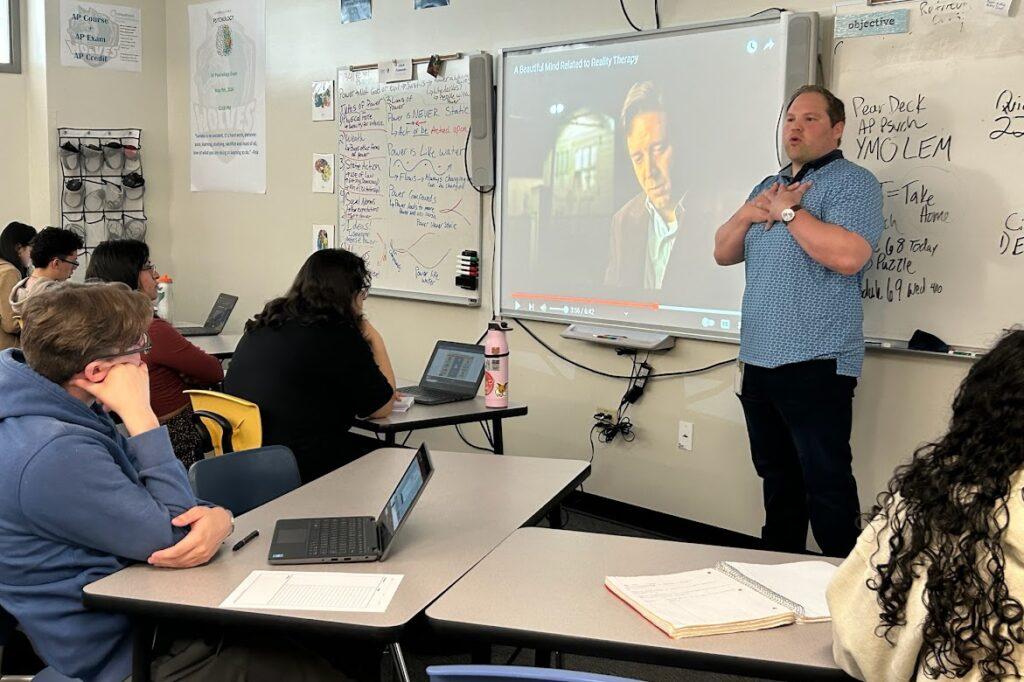
Molly Cruse/CPR Information
Kennelly, animated and enthusiastic, is on the leading edge. A brand new RAND examine reveals that as of the autumn of final yr, simply 18 p.c of educators mentioned they use AI for instructing. Most used it to adapt content material to suit the extent of their college students and to generate educational materials.
Kennelly goes even additional. He is instructing his college students in regards to the immense energy of synthetic intelligence – each good and unhealthy – and letting them use it of their work.
“The chance to discover, experiment, and be taught alongside college students, collaborating with AI, collaborating with college students, them collaborating with me and throughout intelligences, if you’ll, has been actually inspiring to me,” he mentioned.
First, utilizing synthetic intelligence in AP Psychology
This week, the scholars have been learning schizophrenia. Earlier than the movie, Kennelly gave them a quiz he created utilizing synthetic intelligence, which he makes use of recurrently to cut back his workload.
Subsequent up? College students should write a paragraph stating a proposition in regards to the signs of schizophrenia. They’ll use particulars from the movie clips as proof to help their analyses. They write their responses right into a chatbot Kennelly has created utilizing Magic College, a Colorado-based AI platform that lets lecturers monitor college students’ work as they use AI.
“We’re going to get some actually superior suggestions from AI, and then you definitely’re going to enhance it,” Kennelly tells the category. “Once more, the main target is we’re utilizing AI to collaborate to make our work higher — not do the work for us.”
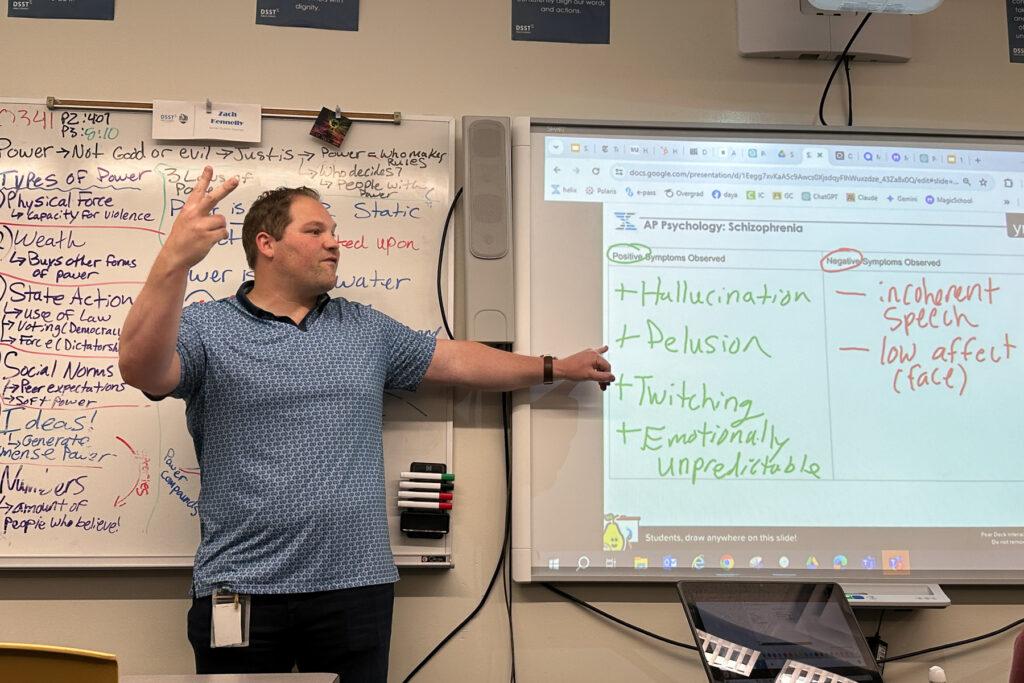
Jenny Brundin/CPR Information
Magic Scholar — from the identical firm that places out Magic College — has an enormous variety of instruments that college students can use like:
- Construct their very own chatbots from scratch
- Create skits
- Do a rap battle between authors or well-known figures in historical past
- Rewrite their very own tales from the angle of a personality in a guide
- Get tutoring
- Get assist rewriting
- Speak to characters from performs
- Get assist coding
- Translation
- Concept era
- And an enormous one: get writing suggestions.
Academics have management over which instruments to launch to college students.
Kennelly, on his laptop computer, screens every pupil as they collaborate with AI. Kennelly calls out to a pupil after she inputs her writing pattern and will get suggestions.
“Amber, what it gave you again might be too prolonged of an instance … Coach it up, inform it to provide you a extra concise instance. 4 to seven sentences, one thing alongside these traces so the suggestions is absolutely actionable for you,” he explains.
Kennelly used AI to supply the framework of sentences that college students can use. They’ll select “delicate,” “medium” or “spicy” based mostly on the problem degree they need. He mentioned these are particularly useful to the English language learners on this class.
Two weeks into the AI pilot, college students are fairly impressed
Sophia, 17, discovered AI’s response to her writing useful.
“I used to be studying it and saying, ‘That is what I lacked,’ so a number of it was getting me the small print of what I used to be lacking like connecting again to scenes (from the movie).”
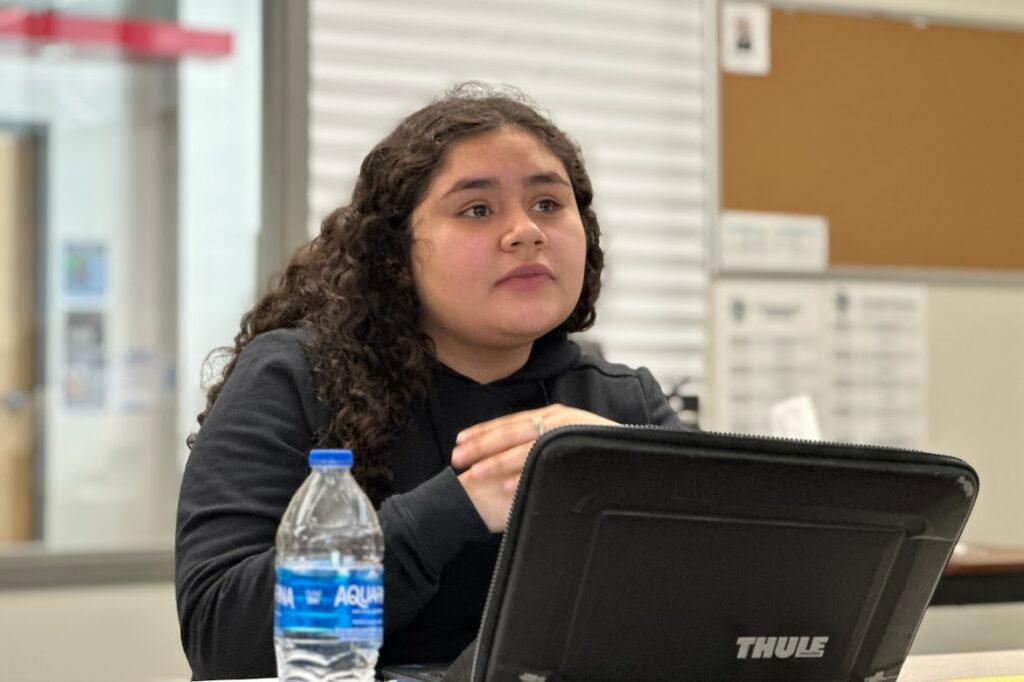
Jenny Brundin/ CPR Information
AI is giving one thing that college information reveals they need most: extra suggestions, extra shortly.
“It was like your built-in instructor supplying you with suggestions on no matter you wanted to, no matter you wanted to work on, whether or not it was a brand new sentence or like, grammar, spelling, no matter … it gave it to you actually fast,” mentioned Brandon, a 17-year-old pupil.
Kennelly mentioned college students in any other case have to attend days generally to get suggestions from him. College students sometimes would hand in an AI-improved model and their authentic.
Additionally they like AI for brainstorming concepts. However in the end, they suppose it would assist them develop into higher writers.
“It is helped make my writing much more concise utilizing phrases that I perhaps have not used earlier than, simply increasing my vocabulary loads,” mentioned Rachel, a 17-year-old pupil.
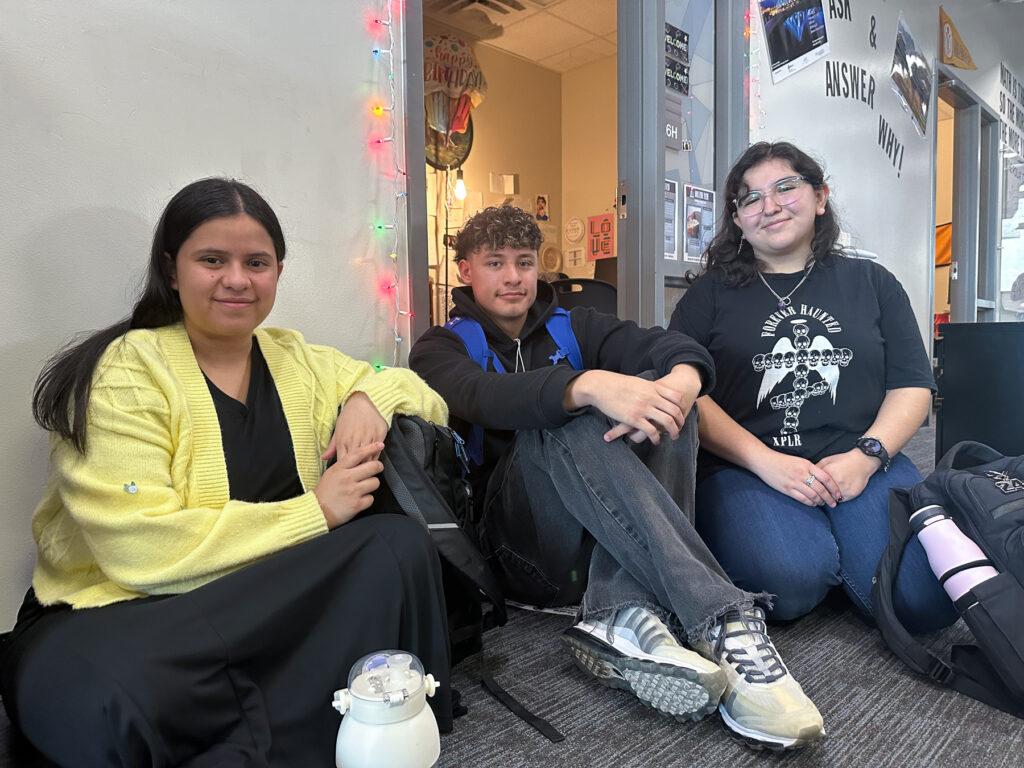
Jenny Brundin/CPR Information
The scholars appear to know intuitively that in the event that they over-rely on AI to jot down, they received’t be taught something. Some educators might argue the wrestle to fill a clean web page is the best way to be taught.
However on this new world, may studying collaborate with AI be a part of the educational journey? However what about if AI spits again suggestions in your writing? Do you have to simply blanket settle for it? This is without doubt one of the strongest instruments on this planet, so it’s gotta be proper, no?
Amber disagrees.
“If AI instructed me, ‘Hey, you may need to change this,’ however I personally really feel prefer it’s sturdy in my protection, I might maintain it. So, AI does not completely overpower the whole lot,” she mentioned.
However that’s one thing college students must be taught and that takes a sure confidence – one thing that Rachel feels is a part of the educational course of.
“Over time, you are going to have the ability to develop the talents as soon as you have seen how AI works.”
And what does the instructor take into consideration the AI experiment thus far?
Kennelly sees a number of potential — but additionally challenges that he’s wanting ahead to tackling.
One problem can be serving to college students discover their very own genuine voice of their writing as they get help from AI. I ask if it could possibly be squashing among the pupil’s creativity. He mentioned at this stage, he doesn’t know.
“And what I imply by that’s I actually do suppose solely time we’ll be capable of inform, and we as educators have such an essential function on this as a result of attempting to ban AI or conceal AI, it is fully futile.”
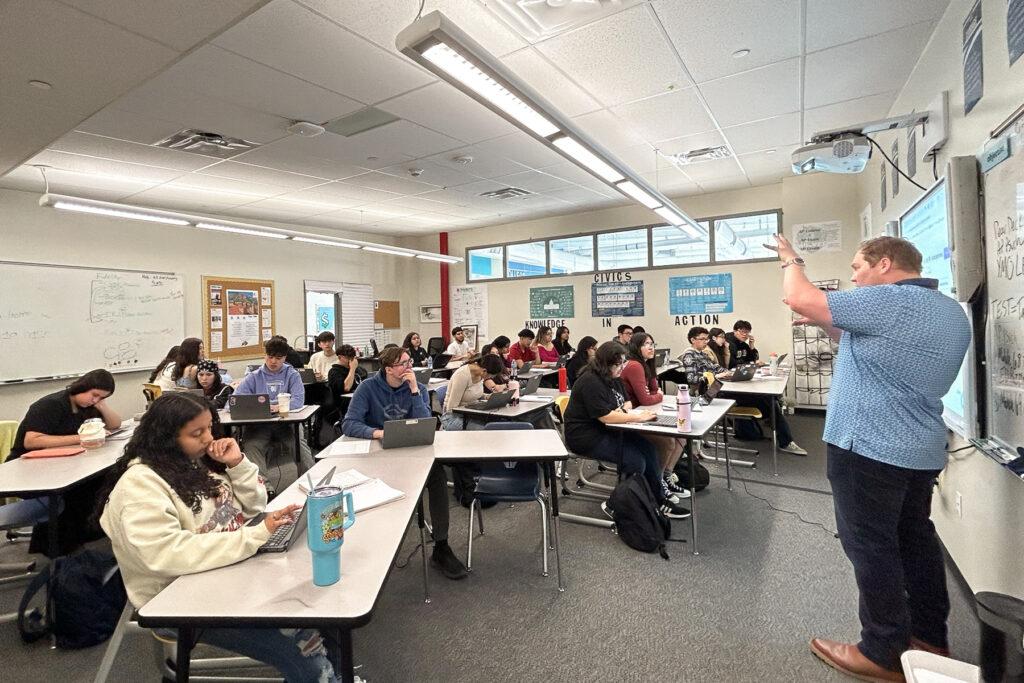
Molly Cruse/CPR Information
He is aware of AI within the classroom remains to be within the experimental section. However the extra lecturers have the liberty to experiment, the extra they’ll refine how this highly effective device needs to be used, he mentioned. Proper now, he’s sensing that utilizing AI in focused spots in school rooms is the best transfer. There are some school rooms the place it in all probability shouldn’t be used as a lot. However there are different challenges.
Serving to college students perceive what it means to collaborate with AI, friends and the instructor — that is actually a better order of considering than what college students do now, which is to research their very own work.
Then there’s privateness. Instructing college students to not put any personally identifiable info into AI is essential.
And one other huge AI studying curve Kennelly will sort out is in civics class.
Subsequent up, utilizing AI in civics class
Kennelly’s subsequent class of the day is civics. This class is learning energy — who holds it, how AI is influencing it, and who’s answerable for regulating it.
They begin the lesson by learning AI-generated pictures and deep fakes, pictures, audio and video which can be digitally altered usually to unfold false info. Then they take a New York Instances quiz to see if they’ll inform which faces have been made by AI. A lot of the class is faked out the vast majority of the time. (One pupil does get 9 out of 10.)
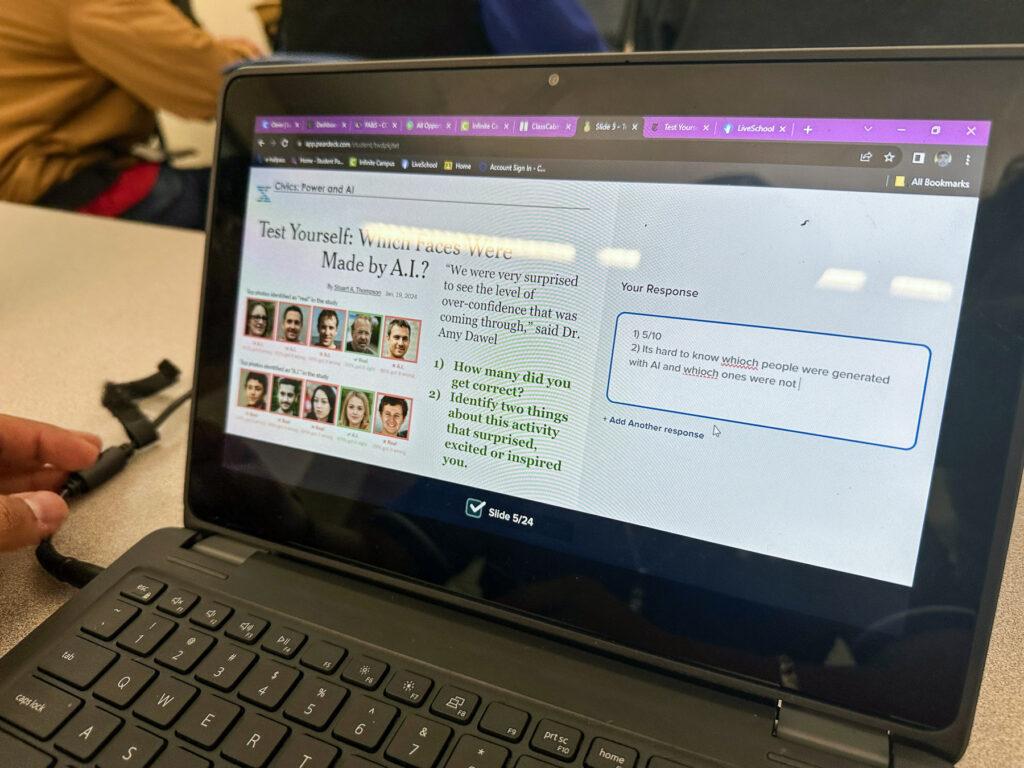
Jenny Brundin/CPR Information
“It made me belief photos much less … there’s some photos the place you suppose it’s actual nevertheless it’s not,” Giovanni mentioned.
“I really feel the very same manner, proper?” Kennelly mentioned. “I’m questioning a lot particularly about social media and information … has this been vetted? Has this been analyzed for some degree of deep pretend? What are among the key issues that I must be looking out for that clearly can successfully mislead me?”
The category examines a graph based mostly on a nationwide survey of the place individuals stand on who ought to regulate AI: trade, authorities or a mixture. One pupil notices that of the individuals who use AI, most imagine there needs to be some type of authorities regulation.
That squares with what Estrella, a senior, thinks about AI regulation.
“If the federal government is just not there to place legal guidelines (in place) to guard us and our private stuff, it’s going to take over,” she mentioned.
The category watches a video on deep fakes, and examines a case examine by deep-fake detector Actuality Defender — a marketing campaign the place Chinese language actors used deep fakes to sow battle and confusion and probably alter a Taiwanese election.
The civics college students first foray into studying in regards to the overwhelming energy of AI is … properly, overwhelming
“I knew about AI however I didn’t suppose a lot about it,” Estrella mentioned. “However after studying about it, it simply blows your thoughts … it’s simply actually huge they usually’re methods to make use of it which can be good and methods it may be unhealthy.”
She mentioned it’s essential to find out about it in highschool. The category has made Jayla extra skeptical of taking what she hears from political candidates at face worth.
“Who you’re voting for may truly not be their true selves … and who you actually need as a president.”
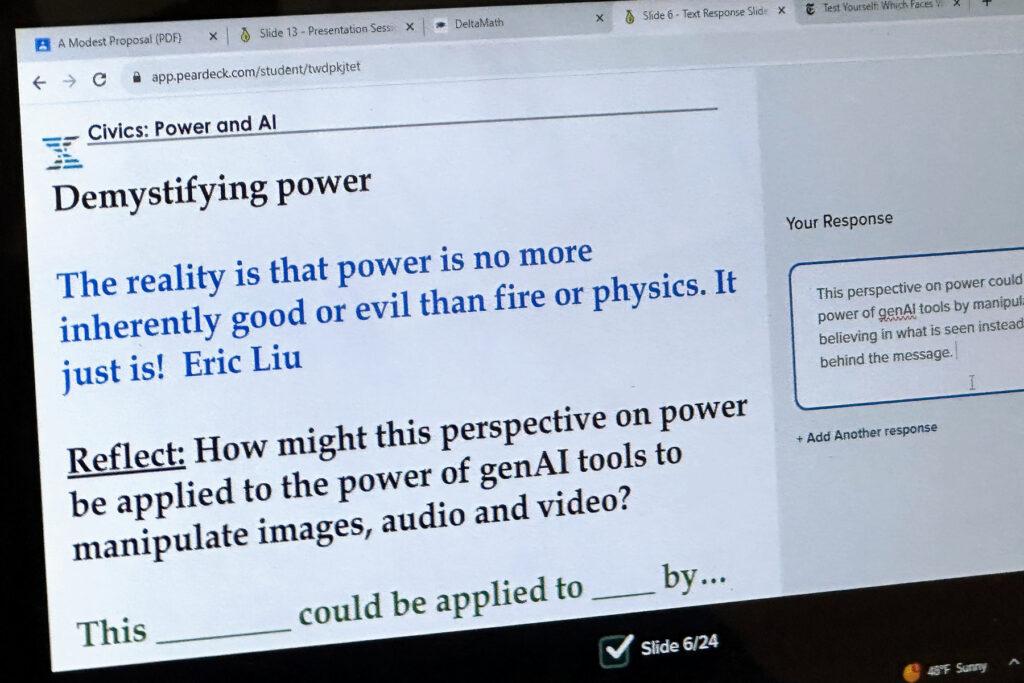
Jenny Brundin/CPR Information
However Kennelly’s aim on this civics class is a optimistic one. Finally the scholars will collaborate with one another and use generative AI instruments to jot down a letter to one in every of their elected representatives a few problem they need to deal with.
The category has already studied the ways in which predictive AI impacts their life, together with their capacity to get a mortgage, to doubtlessly be wrongfully flagged as having dedicated fraud, and to make it more durable to finish the federal monetary assist type (FAFSA).
“Serving to college students notice they’ve energy, they know use their energy, they usually can use AI to scale their energy to handle among the inequities that they see of their world,” Kennelly mentioned.
[ad_2]
Supply hyperlink